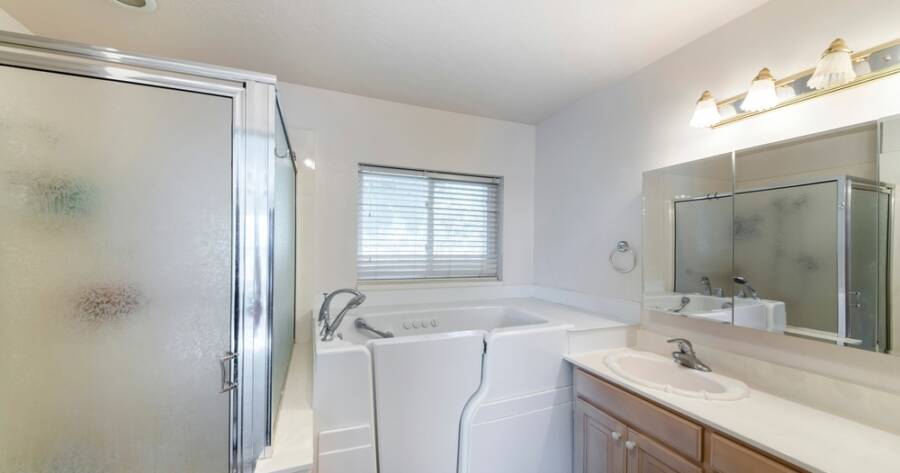Walk-in tubs are becoming increasingly popular as a solution for individuals who require enhanced accessibility and safety while bathing. These specially designed tubs allow users to enter easily by walking through a door, making them a practical option for seniors or those with mobility issues. However, the price of walk-in tubs can vary significantly depending on the type, features, and installation requirements. Understanding the factors that influence the price can help potential buyers make an informed decision and plan for their investment.
Understanding the Cost of Walk-In Tubs
Walk-in tubs typically range in price from $2,000 to $31,500, depending on several factors such as the model type, materials, and added features. Basic models, which often come with standard features like a simple door, seat, and basic jets, start at around $2,000 to $5,000. On the higher end, luxury models, especially those with hydrotherapy jets, whirlpool systems, or wheelchair-accessible designs, can cost upwards of $10,000 to $12,500. Premium features, such as heated backrests, air jets, or chromotherapy lighting, can further increase the price.
In addition to the tub itself, installation costs can range from $1,500 to $10,000, depending on the complexity of the setup. Installation expenses vary based on factors such as the bathroom’s layout, plumbing adjustments, electrical work, and whether any additional remodeling is necessary to accommodate the tub.
Factors Influencing Walk-In Tub Pricing
Several factors affect the price of a walk-in tub, and understanding these elements can help homeowners choose the best option within their budget.
Material Choices: The material of the tub influences both its price and longevity. Acrylic tubs, typically priced between $2,000 and $7,000, are known for their durability, ease of maintenance, and various color options. Fiberglass tubs are generally less expensive, ranging from $2,000 to $6,500, but may not be as durable as acrylic.
Tub Size and Features: Walk-in tubs come in various sizes and configurations. A standard soaker tub with basic features will be more affordable, but a tub with additional functions such as hydrotherapy jets, air bubbles, or therapeutic massage functions will cost significantly more. Custom features, such as grab bars, heated surfaces, and chromotherapy lighting, can also increase the overall price.
Door Type: The type of door in the walk-in tub can also impact pricing. Traditional side-entry doors are typically less expensive, while models with outward-swinging doors or wider entryways for wheelchair access tend to be priced higher.
Safety Features: Walk-in tubs are designed with safety in mind, and features such as slip-resistant floors, built-in seating, and easy-to-use controls can affect the price. Some tubs also offer advanced safety features like anti-scald valves and emergency drain systems, which can increase the cost.
Installation and Additional Costs
The cost of installation can often exceed expectations, as it requires more than just placing the tub in position. Installation involves modifying plumbing and potentially altering bathroom layouts. If your bathroom does not have the space to accommodate the tub, additional construction may be necessary, such as widening doorways, reinforcing the floor, or installing electrical outlets for features like heated seats or lighting.
In simpler installations, the cost can be as low as $1,800. However, if extensive plumbing or electrical work is required, installation costs can climb to $10,000 or more. Be sure to get a comprehensive quote from a professional installer to understand the full scope of work involved.
Financial Assistance and Value
Although walk-in tubs can be a significant investment, various financial assistance options may help offset the cost. In some cases, health insurance may cover a portion of the expense if the tub is deemed medically necessary. Additionally, some government programs or non-profits may offer financial aid for senior citizens or individuals with disabilities to make their homes more accessible.
Not only do walk-in tubs offer enhanced safety and independence for those with mobility challenges, but they can also increase the overall value of your home. Accessibility features are highly valued in homes, particularly in communities with an aging population. A walk-in tub can make your home more attractive to future buyers, especially those looking for properties that cater to elderly or disabled individuals.
Choosing the Right Walk-In Tub Contractor
When purchasing a walk-in tub, it’s essential to choose a qualified contractor for installation. Research different installers, read reviews, and ask for recommendations from other customers. Be sure to ask questions about warranties, post-installation services, and any potential hidden fees.
It’s also important to consider the manufacturer’s reputation. Choose a reputable brand known for high-quality tubs and reliable customer service. Compare features, materials, and warranty options to find a tub that suits your needs and budget.
Why You Should Learn More About Walk-In Tubs Today
Investing in a walk-in tub offers numerous benefits, including increased safety, independence, and comfort. Understanding the cost factors and the available financial assistance options can help you make an informed decision. A walk-in tub is not only a smart choice for accessibility but also a home improvement that can add long-term value to your property.
By considering the features that matter most to you and your family, you can choose the right walk-in tub that fits both your needs and budget. Don’t overlook the importance of proper installation to ensure optimal functionality and safety. With the right planning, a walk-in tub can enhance your home’s accessibility, making bathing a safer and more enjoyable experience for years to come.
